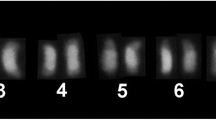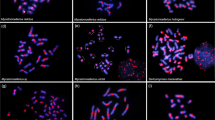Abstract
The eukaryote genome is enriched by different types of repetitive DNA sequences and is most abundant in heterochromatin regions. Historically, no function has been assigned to these sequences, which makes them the target of studies that have demonstrated their structural and functional importance in the genome. Despite having a constant chromosome number, the genus Melipona has species with wide variation in heterochromatin content, from 8 to 73%, which is an important feature to be investigated regarding its origin and evolution. In the present study, a repetitive DNA sequence of Melipona mondury was isolated by restriction enzyme digestion. This sequence was used to hybridize chromosomes of eight Melipona species that include representatives of the four subgenera and present divergent characteristics in relation to the heterochromatin content. Considering that rDNA localization has shown differences in Melipona, 16 species of this genus were analyzed with 18S rDNA probe. Our data suggest that heterochromatin growth occurred independently in the Michmelia and Melikerria subgenera, considering that the isolated repetitive DNA sequence was shared only by the Michmelia species. Amplification possibly occurred from the centromeric region, causing the displacement of the rDNA sites to the ends of the chromosomes. The repetitive DNA sequence used is a constituent of Michmelia heterochromatin, which that arose from the common ancestor of the species of this subgenus.




Similar content being viewed by others
References
Andrade-Souza V, Duarte OMP, Martins CCC, Santos IS, Costa MGC, Costa MA (2018) Comparative molecular cytogenetics in MeliponaIlliger species (Hymenoptera, Apidae). Sociobiology 64(4):696–705. https://doi.org/10.13102/sociobiology.v65i4.3480
Camargo JMF, Pedro SRM (2013) Meliponini Lepeletier, 1836. In: Moure JS, Urban D, Melo GAR (eds) Catalogue of bees (Hymenoptera, Apoidea) in the neotropical region. SociedadeBrasileira de Entomologia, Curitiba, pp 272–578
Charlesworth B, Paul S, Wolfgang S (1994) The evolutionary dynamics of repetitive DNA in eukaryotes. Nature 371(6494):215–220. https://doi.org/10.1038/371215a0
Cunha MS, Travenzoli NM, Ferreira RP, Cassinela EK, Silva H, Salomão TMF, Lopes DM (2018) Comparative cytogenetics in three Melipona species (Hymenoptera: Apidae) with two divergent heterochromatic patterns. Genet MolBiol 41(4):806–813. https://doi.org/10.1590/1678-4685-gmb-2017-0330
Cunha MS, Campos LAO, Lopes DM (2020) Insights into the heterochromatin evolution in the genus Melipona (Apidae: Meliponini). InsectesSoc. https://doi.org/10.1007/s00040-020-00773-6
Dover GA (1982) Molecular drive: a cohesive mode of species evolution. Nature 299(5879):111–117. https://doi.org/10.1038/299111a0
Dover GA (1986) Molecular drive in multigene families: how biological novelties arise, spread and are assimilated. Trends Genet 2:159–165. https://doi.org/10.1016/0168-9525(86)90211-8
Dover GA (2002) Molecular drive. Trends Genet 18(11):587–589
Ferree PM, Prasad S (2012) How can satellite DNA divergence cause reproductive isolation? Let us count the chromosomal ways. Genet Res Int. https://doi.org/10.1155/2012/430136
Garrido-Ramos MA (2017) Satellite DNA: An evolving topic. Genes 8(9):230. https://doi.org/10.3390/genes8090230
Grewal SIS, Jia S (2007) Heterochromatin revised. Nat Rev 8(1):35–46. https://doi.org/10.1038/nrg2008
Hsieh J, Fire A (2000) Recognition and silencing of repeated DNA. Annu Rev Genet 34(1):187–204
Huang YC, Lee CC, Kao CY, Chang NC, Lin CC, Shoemaker D, Wang J (2016) Evolution of long centromeres in fire ants. BMC EvolBiol 16(1):189. https://doi.org/10.1186/s12862-016-0760-7
Imai HT, Taylor RW, Crosland MW, Crozier RH (1988) Modes of spontaneous chromosomal mutation and karyotype evolution in ants with reference to the minimum interaction hypothesis. Jpn J Gen 63(2):159–185. https://doi.org/10.1266/jjg.63.159
Lopes DM, Pompolo SG, Campos LAO, Tavares MG (2008) Cytogenetic characterization of MeliponarufiventrisLepeletier 1836 and Meliponamondury Smith 1863 (Hymenoptera, Apidae) by C banding and fluorochromes staining. Genet MolBiol 31:49–52. https://doi.org/10.1590/S1415-47572008000100010
Lopes DM, Fernandes A, Praça-Fontes MM, Werneck HDA, Resende HC, Campos LAO (2011) Cytogenetics of three Melipona species (Hymenoptera, Apidae, Meliponini). Sociobiology 57(2):185–194. https://doi.org/10.13102/sociobiology.v65i4.3480
Martínez-Lage A, González-Tizón A, Méndez J (1995) Chromosomal markers in three species of the genus Mytilus (Mollusca: Bivalvia). Heredity 74(4):369. https://doi.org/10.1038/hdy.1995.55
Martins C, Cabral-de-Mello DC, Valente GT, Mazzuchelli J, Oliveira SG (2011) Cytogenetic mapping and contribution to the knowledge of animal genomes. In: Urbano KV (ed) Advances in genetics research, 4th edn. Nova Science Publishers, Inc, Hauppauge, pp 1–81
Palomeque T, Lorite P (2008) Satellite DNA in insects: a review. Heredity 100:564–573. https://doi.org/10.1038/hdy.2008.24
Pérez-Gutiérrez MA, Suárez-Santiago VN, López-Flores I, Romero AT, Garrido-Ramos MA (2012) Concerted evolution of satellite DNA in Sarcocapnos: a matter of time. Plant MolBiol 78(1–2):19–29. https://doi.org/10.1007/s11103-011-9848-z
Piccoli MCA, Bardella VB, Cabral-de-Mello DC (2018) Repetitive DNAs in Meliponascutellaris (Hymenoptera: Apidae: Meliponidae): chromosomal distribution and test of multiple heterochromatin amplification in the genus. Apidologie 49(4):497–504. https://doi.org/10.1007/s13592-018-0577-z
Pinkel D, Straume T, Gray JW (1986) Cytogenetic analysis using quantitative, high sensitivity, fluorescence hybridization. ProcNatlAcadSci USA 83(9):2934–2938. https://doi.org/10.1073/pnas.83.9.2934
Plohl M, Meštrović N, Mravinac B (2012) Satellite DNA evolution. Genome Dyn 7:126–152
Ramírez SR, Nieh JC, Quental TB, Roubik DW, Imperatriz-Fonseca VL, Pierce NE (2010) A molecular phylogeny of the stingless bee genus Melipona (Hymenoptera: Apidae). MolPhylogEvol 56(2):519–525. https://doi.org/10.1016/j.ympev.2010.04.026
Rasmussen C, Cameron AS (2010) Global stingless bee phylogeny supports ancient divergence, vicariance, and long distance dispersal. Biol J Linn Soc 99(1):206–232. https://doi.org/10.1111/j.1095-8312.2009.01341.x
Richard GF, Kerrest A, Dujon B (2008) Comparative genomics and molecular dynamics of DNA repeats in eukaryotes. MicrobiolMolBiol Rev 72(4):686–727. https://doi.org/10.1128/MMBR.00011-08
Rocha MP, Pompolo SG (1998) Karyotypes and heterochromatin variation (C-bands) in Melipona species (Hymenoptera, Apidae, Meliponinae). Genet MolBiol 21(1):41–45. https://doi.org/10.1590/S1415-47571998000100008
Rocha MP, Pompolo SG, Dergam JA, Fernandes A, Campos LAO (2002) DNA characterization and karyotypic evolution in the bee genus Melipona (Hymenoptera Meliponini). Hereditas 136(1):19–27. https://doi.org/10.1034/j.1601-5223.2002.1360104.x
Salser W, Bowen S, Browne D, El Adli F, Fedoroff N, Fry K, Heindell H, Paddock G, Poon R, Wallace B, Whitcome P (1976) Investigation of the organization of mammalian chromosomes at the DNA sequence level. Fed Proc 35(1):23–35
Silva PC, Santos U, Travenzoli NM, Zanuncio JC, Cioffi MDB, Dergam JA (2012) The unique karyotype of Henochiluswheatlandii, a critically endangered fish living in a fast-developing region in Minas Gerais State Brazil. PLoS ONE 7(7):e42278. https://doi.org/10.1371/journal.pone.0042278
Tavares MG, Carvalho CR, Soares FAF (2010) Genome size variation in Melipona species (Hymenoptera: Apidae) and sub-grouping by their DNA content. Apidologie 41(6):636–642. https://doi.org/10.1051/apido/20010023
Tavares MG, Lopes DM, Campos LAO (2017) An overview of cytogenetics of the tribe Meliponini (Hymenoptera: Apidae). Genetica 145(3):241–258. https://doi.org/10.1007/s10709-017-9961-2
Travenzoli NM, Silva PC, Santos U, Zanuncio JC, Oliveira C, Dergam JA (2015) Cytogenetic and molecular data demonstrate that the Bryconinae (Ostariophysi, Bryconidae) species from Southeastern Brazil form a phylogenetic and phylogeographic unit. PLoS ONE 10(9):e0137843. https://doi.org/10.1371/journal.pone.0137843
Travenzoli NM, Lima BA, Cardoso DC, Dergam JA, Fernandes-Salomão TM, Lopes DM (2019b) Cytogenetic analysis and chromosomal mapping of repetitive DNA in Melipona species (Hymenoptera, Meliponini). Cytogenet Genome Res 158(4):213–224
Travenzoli NM, Barbosa IC, Carvalho-Zilse GA, Salomão TMF, Lopes DM (2019a) Karyotypic description and repetitive DNA chromosome mapping of MeliponainterruptaLatreille, 1811 (Hymenoptera: Meliponini). Caryologia 72(2):91–95. https://doi.org/10.13128/cayologia-239
Ugarkovic D (2005) Functional elements residing within satellite DNAs. EMBO Rep 6(11):1035–1039. https://doi.org/10.1038/sj.embor.7400558
Ventura K (2009) Estudos de citogenética e de filogenia molecular em roedores da tribo Akodontini. Thesis, Instituto de Biociências da Universidade de São Paulo. Departamento de Genética e Biologia Evolutiva
Vicari MR, Nogaroto V, Noleto RB, Cestari MM, Cioffi MB, Almeida MC, Moreira-Filho O, Bertollo LAC, Artoni RF (2010) Satellite DNA and chromosomes in Neotropical fishes: methods, applications and perspectives. J Fish Biol 76(5):1094–1116. https://doi.org/10.1111/j.1095-8649.2010.02564.x
Waldschmidt AM, Salomão TMF, Barros EGD, Campos LDAO (1997) Extraction of genomic DNA from Meliponaquadrifasciata (Hymenoptera: Apidae, Meliponinae). Braz J Genet 20:3. https://doi.org/10.1590/S0100-84551997000300011
Acknowledgements
The authors would like to thank the “Coordenação de Aperfeiçoamento de Pessoal de Nível Superior (CAPES)” and “Fundação de Amparo à Pesquisa do Estado de Minas Gerais (FAPEMIG)”.
Author information
Authors and Affiliations
Corresponding author
Ethics declarations
Conflict of interest
The authors declare that they have no conflict of interest.
Additional information
Publisher's Note
Springer Nature remains neutral with regard to jurisdictional claims in published maps and institutional affiliations.
Supplementary Information
Below is the link to the electronic supplementary material.
Rights and permissions
About this article
Cite this article
Pereira, J.A., Travenzoli, N.M., de Oliveira, M.P. et al. Molecular cytogenetics in the study of repetitive sequences helping to understand the evolution of heterochromatin in Melipona (Hymenoptera, Meliponini). Genetica 149, 55–62 (2021). https://doi.org/10.1007/s10709-020-00111-5
Received:
Accepted:
Published:
Issue Date:
DOI: https://doi.org/10.1007/s10709-020-00111-5





